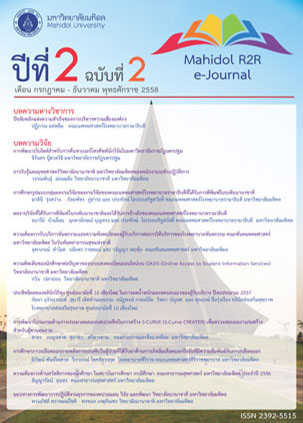การศึกษาภาวะเลือดออกภายหลังการถอนฟันในผู้ป่วยที่ได้รับ ยาต้านการเกิดลิ่มเลือดและปัจจัยที่มีความสัมพันธ์กับภาวะเลือดออก
DOI:
https://doi.org/10.14456/jmu.2015.14คำสำคัญ:
ภาวะเลือดออกภายหลังการถอนฟัน, ยาต้านการเกิดลิ่มเลือด, ยาต้านเกล็ดเลือด, ยาต้านการแข็งตัวของเลือดบทคัดย่อ
การศึกษานี้มีวัตถุประสงค์เพื่อศึกษาอุบัติการณ์ของภาวะเลือดออกภายหลังการถอนฟันในผู้ป่วยที่ได้รับยาต้านการเกิดลิ่มเลือด ซึ่งอาจจะเป็นยาต้านเกล็ดเลือดและ/หรือยาต้านการแข็งตัวของเลือด; วาร์ฟาริน โดยผู้ป่วยรับประทานยาต้านการเกิดลิ่มเลือดอย่างต่อเนื่องก่อนการถอนฟัน การศึกษานี้ได้ทำการรวบรวมข้อมูลผู้ป่วยที่มารับการถอนฟันที่งานทันตกรรม โรงพยาบาลศิริราช คณะแพทยศาสตร์ศิริราชพยาบาล มหาวิทยาลัยมหิดล จากเวชระเบียนผู้ป่วยย้อนหลัง ตั้งแต่เดือนสิงหาคม พ.ศ.2554 ถึงเดือนกุมภาพันธ์ พ.ศ.2556 จำนวนทั้งหมด 412 ราย เป็นชาย 243 ราย หญิง 169 ราย ช่วงอายุ 25 – 98 ปี โดยผู้ป่วยทั้งหมด 412 รายนี้ 330 รายได้รับยาต้านเกล็ดเลือดอย่างเดียว 59 รายได้รับยาวาร์ฟารินอย่างเดียว และ 23 รายได้รับยาต้านเกล็ดเลือดร่วมกับยาวาร์ฟาริน จำนวนฟันที่ถูกถอนทั้งหมด 648 ซี่ ผลการศึกษาพบว่าอุบัติการณ์ของภาวะเลือดออกภายหลังการถอนฟันในผู้ป่วยที่ได้รับยาต้านการเกิดลิ่มเลือดเกิดขึ้น 11 ราย (ร้อยละ 2.7) โดยผู้ป่วยที่ได้รับยาวาร์ฟารินเกิดภาวะเลือดออกมากกว่าผู้ป่วยที่ได้รับยาต้านเกล็ดเลือดอย่างมีนัยสำคัญ ซึ่งผู้ป่วยทั้ง 11 รายได้รับการรักษาโดยการห้ามเลือดเฉพาะที่
เอกสารอ้างอิง
Bajkin BV, Urosevic IM, Stankov KM, Petrovic BB, Bajkin IA. Dental extractions and risk of bleeding in patients taking single and dual antiplatelet treatment. Br J Oral Maxillofac Surg 2015;53:39-43.
Evans IL, Sayers MS, Gibbons AJ, Price G, Snooks H, Sugar AW. Can warfarin be continued during dental extraction?Result of a randomized controlled trial. Br J Oral Maxillofac Surg 2002;40:248-52.
Hirsh J, Dalen J, Anderson DR, Poller L, Bussey H, Ansell J, Deykin D. Oral anticoagulants: mechanism of action, clinical effectiveness, and optimal therapeutic range. Chest 2001;119 Suppl:8S-21S.
Lockhart PB, Gibson J, Pond SH, Leitch J. Dental management considerations for the patient with an acquired coagulopathy. Part 1: coagulopathies from systemic disease. Br Dent J 2003;195:439-45.
Maulaz AB, Bezerra DC, Michel P, Bogousslavsky J. Effect of discontinuing aspirin therapy on the risk of brain ischemic stroke. Arch Intern Med 2005;62:1217-20.
Morimoto Y, Niwa H, Minematsu K. Hemostatic management of tooth extractions in patients on oral antithrombotic therapy. J Oral Maxillofac Surg 2008;66:51-7.
Morimoto Y, Niwa H, Minematsu K. Hemostatic management for periodontal treatments in patients on oral antithrombotic therapy: a retrospective study. Oral Surg Oral Med Oral Pathol Oral Radiol Endod 2009;108:889-96.
Morimoto Y, Niwa H, Minematsu K. Risk factors affecting postoperative hemorrhage after tooth extraction in patients receiving oral antithrombotic therapy. J Oral Maxillofac Surg 2011;69:1550-6.
Oake N, Jennings A, Forster AJ, Fergusson D, Doucette S, van Walraven C. Anticoagulation intensity and outcomes among patients prescribed oral anticoagulant therapy: a systematic review and meta-analysis. CMAJ 2008;179:235-44.
Scully C, Wolff A. Oral surgery in patients on anticoagulant therapy. Oral Surg Oral Med Oral Pathol Oral Radiol Endod 2002;94:57-64.
Wahl MJ. Dental surgery in anticoagulated patients. Arch Intern Med 1998;158:1610-6.
ดาวน์โหลด
เผยแพร่แล้ว
ฉบับ
ประเภทบทความ
สัญญาอนุญาต




